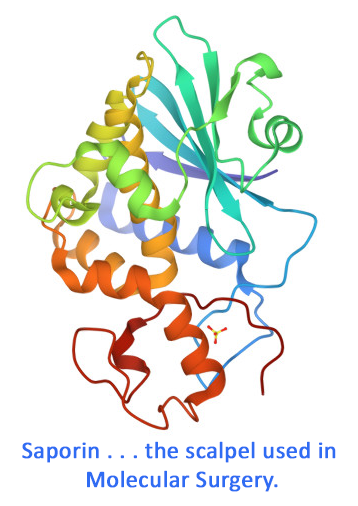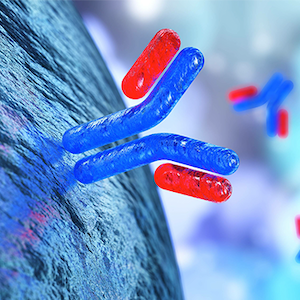Saporin is obtained from the seeds of the Soapwort plant (Saponaria officinalis), a plant that grows wildly in Britain and other parts of Europe. Saporin is a plant enzyme with N-glycosidase activity that depurinates a specific nucleotide in the ribosomal RNA 28S, thus irreversibly blocking protein synthesis. It belongs to the well-characterized family of ribosome-inactivating proteins (RIPs). There are two types of RIPs: type I, which are much less cytotoxic due to the lack of the B chain and type II, which are distinguished from type I RIPs by the presence of the B chain and their ability to enter cells on their own. However, type I RIPs can still be internalized by fluid-phase endocytosis. Upon internalization, the ribosomes are inactivated, resulting in cell death.
This antibody recognizes native and recombinant saporin. It was developed in chicken using saporin and was purified from chicken egg yolk. The antibody is routinely tested by western blot.
Applications include immunoblotting, ELISA, and flow cytometry.
keywords: saporin, saponaria officinalis, plant enzyme, RIP, ribosome-inactivating protein, RIP I, internalization, cell death, Anti-Saporin, Anti-SAP
Single domain antibodies for the detection of ricin using silicon photonic microring resonator arrays.
Shia WW, Bailey RC (2013) Single domain antibodies for the detection of ricin using silicon photonic microring resonator arrays. Anal Chem 85(2):805-810. doi: 10.1021/ac3030416 PMID: 23268548
Summary: A major hurdle to clear in the fight against bioterrorism is the ability to identify various biowarfare agents. One of the more difficult substances to identify is ricin. This work describes the use of single domain antibodies to identify ricin in a microring resonator array assay. Saporin (Cat. #PR-01) along with affinity purified chicken anti-saporin (Cat. #AB-17AP) were used as controls when constructing the assay. The results demonstrate the feasibility of using microring resonator arrays for the detection of biowarfare agents.
Related Products: Saporin Chicken Polyclonal, affinity-purified (Cat. #AB-17AP), Saporin (Cat. #PR-01)
Hypocretin-2-saporin lesions of the lateral hypothalamus produce narcoleptic-like sleep behavior in the rat.
Gerashchenko D, Kohls MD, Greco M, Waleh NS, Salin-Pascual R, Kilduff TS, Lappi DA, Shiromani PJ (2001) Hypocretin-2-saporin lesions of the lateral hypothalamus produce narcoleptic-like sleep behavior in the rat. J Neurosci 21(18):7273-7283. doi: 10.1523/JNEUROSCI.21-18-07273.2001 PMID: 11549737
Summary: Orexin (also knows as hypocretin) peptides are produced exclusively by neurons in the lateral hypothalamus, however non-specific lesioning in this region has not produced narcoleptic-like sleep. Gerashchenko et al. use orexin-SAP (490 ng/0.5 µl; Cat. #IT-20) to specifically eliminate orexin neurons in rats. The treated rats displayed several sleep disturbances found in narcolepsy, including increased slow-wave sleep, and sleep-onset REM sleep periods. The data suggest that orexin-SAP can be used to create a model for narcolepsy in rats.
Related Products: Orexin-B-SAP (Cat. #IT-20), Saporin Goat Polyclonal, affinity-purified FITC-labeled (Cat. #AB-15APFL), Saporin Chicken Polyclonal, affinity-purified (Cat. #AB-17AP)
Differential changes in rat cholinergic parameters subsequent to immunotoxic lesion of the basal forebrain nuclei.
Waite JJ, Chen AD (2001) Differential changes in rat cholinergic parameters subsequent to immunotoxic lesion of the basal forebrain nuclei. Brain Res 918:113-120. doi: 10.1016/s0006-8993(01)02968-7 PMID: 11684049
Summary: 192-Saporin (Cat. #IT-01) is used extensively to eliminate the cholinergic neurons of the basal forebrain in rats. Waite and Chen compare the degree of loss between 192-Saporin (6 or 8.2 µg in 10 µl into left lateral ventricle) and control (Saporin, 1.82 µg into left lateral ventricle; Cat. #PR-01) using three methods: Assay of post mortem choline acetyltransferase activity, in vivo microdialysis of extracellular acetylcholine (ACh), and in vivo assessment of the rate of ACh synthesis. The infusion of saporin alone had no effect. After fifteen weeks, the authors report compensation of cholinergic activity in lesioned animals occurs in the hippocampus, but not in the frontal cortex as determined by measurement of the rate of ACh synthesis.
Related Products: 192-IgG-SAP (Cat. #IT-01), Saporin Goat Polyclonal (Cat. #AB-15), Saporin Chicken Polyclonal, affinity-purified (Cat. #AB-17AP), Saporin (Cat. #PR-01)
browse all references for this product | back to top



Reviews
There are no reviews yet.